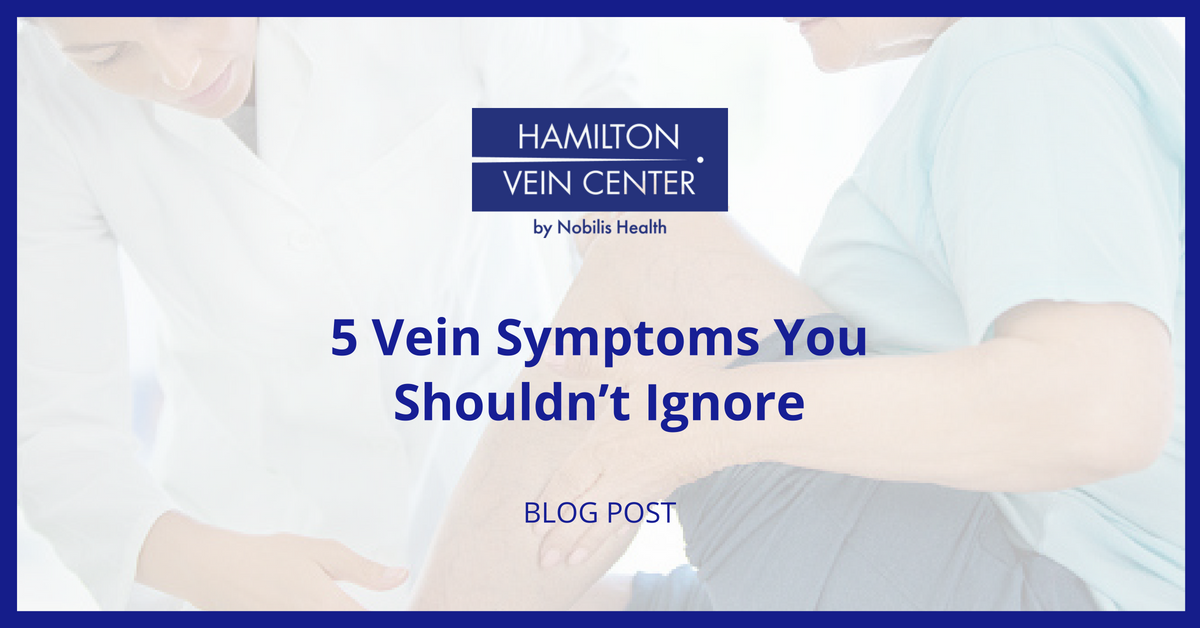5 Vein Symptoms You Shouldn’t Ignore

Signs of Trouble
Many people may assume that things like varicose veins, heaviness in the legs, or skin discoloration are more inconveniences and aesthetic problems than serious symptoms. They may try to just sort of live with it, pushing through despite the discomfort. However, these signs should not be taken lightly, as they can actually be pointing towards more serious and potentially even fatal health problems.
Conditions like chronic venous insufficiency (CVI), especially if untreated, can lead to extremely dangerous deep vein thrombosis (DVT), or blood clots of larger, deeper veins. It’s therefore important to be responsive if you start seeing or feeling symptoms of vein problems. Timely treatment will resolve most if not all issues and could, quite literally, be a lifesaver.
But what symptoms should you be on the look out for? Which ones might be signs of deeper problems? Here’s a quick breakdown:
- Varicose Veins
In many cases, the appearance of large, discolored veins aren’t necessarily dangerous and can easily be treated. Basically, these occur because, due to weakening of vein walls, blood in the legs is unable to get back to the heart, collecting and pooling in the legs. That said, their appearance might also be a sign of more serious problems, like CVI, or, depending on location, pelvic vein stenosis, a dangerous blockage of superficial arteries. If these go untreated, there’s an increased risk of very troubling medical conditions.
- Leg Pain & Swelling
Leg pain and swelling occurs with a range of vein conditions, and, as with other symptoms, often arise due to an inability of blood to get back to the heart. It’s particularly important to be mindful if these are felt in only one leg, as that could be a sign that a vein on one side of the body is fully or close to clotted. These symptoms also make the legs very sensitive; the slightest contact can be excruciating. While these do accompany less-severe varicose vein cases, they shouldn’t be ignored as they imply the risk of developing DVT or an already established case. Make sure to get yourself checked out.
- Cramps
Leg cramps can occur for a variety of reasons: dehydration, overuse of muscle, as well as blood circulation problems. You should be particularly vigilant if these occur at night because this implies that blood and other fluids are unable to travel back from the legs to the heart during the day (when you’re seated or standing). As such, they can be a sign of CVI or related conditions. Call your doctor especially if you’re experiencing these cramps along other leg symptoms.
- Skin Discoloration
Another potential sign of CVI or other more-serious vein circulation issues like venous reflux syndrome is skin discoloration. Full or partial blockages in the legs can cause things like red streaks along veins, and persistent and easy bruising. Essentially, pooled blood that’s unable to get back to where it needs to go can essentially flood certain areas and “stain” the skin. Again, these symptoms are particularly important to track if you’re experiencing others in this list.
- Leg Ulcers
This is definitely a sign of serious problems. Prolonged cases of vein disease limit the amount of oxygen that gets to the legs, making it more difficult for wounds to heal and making the area less resilient overall. Patients may find what starts as a red-colored rash turns into an open wound. These ulcers either do not heal at all or do so very slowly and are definitely a sign that you need medical attention. Be especially mindful if you also experience leg heaviness, itchiness, or swelling in the leg or legs.
The First Step: The Right Step
The good news is that even the most severe vein disorders can be treated effectively. Remember: The sooner you’re able to seek out treatment, the more manageable the case will be. When it comes to conditions like CVI or related diseases, a timely intervention will also prevent fatal conditions like DVT or pulmonary embolism, in which a piece of clotted blood gets lodged in the heart.
There’s no denying how important blood is for the body, so it’s up to you to make sure it’s doing the necessary work. Seeking medical attention could not only clear things up and improve your daily-life; it could save your life.
If you’re experiencing vein disease symptoms or believe you do, the team at Hamilton Vein Center can help. These experts employ the latest in techniques and technologies to ensure positive outcomes for their patients. Learn more about what this Texas-based team can do for you by calling their Houston location at (281) 565-0033, the Austin office at (512) 551-1403, or San Antonio at (210) 504-4304.